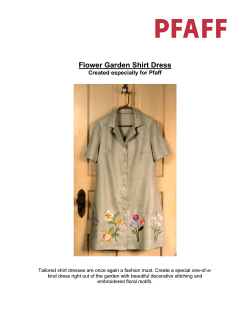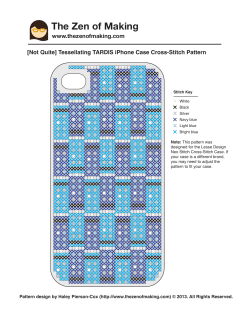
Cutwork in the Kitchen By Sara Boughner, Education Consultant Supplies:
Cutwork in the Kitchen By Sara Boughner, Education Consultant and host of “Behind the Seams” Supplies: • “Retro Apron” pattern by Taylor Made Designs • Pattern Tracing Paper • Sharp Fabric Scissors • smart by Pfaff 350P • Spray Starch • Pfaff creative 2170 • Embroidery Needle • Pfaff creative Endless Hoop • Black Inspira Tear Away • Pfaff Embroidery Collection #399 Endless Cutwork Stabilizer • Appliqué Scissors • Piping Foot • Chalk Marking Pencil • ¼” Right Guide Foot with IDT • Robison-Anton Rayon • Bi-Level Topstitch Foot Embroidery thread to • Stitch in Ditch Foot match silk pieces • 2 yards Purple Silk Fabric • Construction Thread • ½ yard Green Silk Fabric • Piping Hot Binding Tool • ½ yard Fuchsia Silk Fabric • Rotary Cutter and Mat • 3 yds 1/8” cording for piping • Iron For additional ideas visit www.pfaffusa.com Preparation: 1. 2. 3. 4. 5. 6. 7. Trace pattern pieces for pattern C on tracing paper. Using the smart by Pfaff 350P, add texture to the 1½ yards of purple silk by felting it--the five barbed needles will give the silk a whole new look! Cut apron piece out of textured purple silk. Spray starch and press remaining purple, fuchsia and green silk. Cut out two yokes, one ruffle one pocket piece, and two ties from the purple silk using the traced pattern pieces. Cut out one pocket and one ruffle piece out of fuchsia silk. Cut enough 1” bias strips of green silk to make piping for the bottom of the yoke and top of the ruffle. Ruffle Embroidery and Construction: 1. 2. 3. 4. 5. 6. Transfer design #399017 from the Endless Cutwork collection to your Pfaff creative 2170. Insert the Embroidery needle. Thread with your choice of Robison Anton, rayon embroidery thread on top and bobbin thread in the bobbin. Attach the creative Endless Hoop to the machine and recognize the hoop. Slide black tear away stabilizer into hoop. Position the ruffle cut from purple silk on top, aligning the center chalk line with the center registration marks on the hoop. You will want to begin your embroidery approximately ½” from the cut edge. Close hoop, making sure your fabric is straight. Begin embroidery. When the machine stops for a “Color Change,” use the appliqué scissors to cut away the silk inside the stitching to create your cutwork design. Be careful not to cut the stabilizer. Resume embroidery. Because this is an endless design, machine will stitch a set of registration marks in the corners upon completion of the design. Continue embroidering down the entire length of the ruffle, sliding the silk and stabilizer to a new position within the hoop each time a design is completed. You will need to repeat the design five times for a total of six. 7. Use the registration marks to be sure that you are aligned properly. Advance to stitch #7, manually turn the hand wheel to lower the needle. Check that the needle goes into the same stitch hole as the top right corner alignment stitch of the previous design; if not, adjust your fabric placement in the hoop. This part is a little tricky. You are embroidering around a curved piece of fabric, so your design will not match exactly on both corner alignment stitches. Advance through an additional 10 stitches to check that the design is positioned approximately 1” from the bottom edge. 8. When you are satisfied with your positioning, touch the Pattern Start button to go back to the beginning of the design and begin embroidery. 9. Tear away all excess stabilizer and trim away all jump stitches. 10. Set your machine for straight stitch, raise your feed dogs and snap on the ¼” Right Guide foot. Thread your machine with matching construction thread top and bobbin. 11. Layer right side of embroidered ruffle onto right side of fuchsia silk ruffle. Stitch around three sides using the ¼” Right Guide foot with IDT. Leave the top edge open where the ruffle will attach to the apron. 12. Clip your seams around the curves, press your seams open, turn right side out and press flat. The Pocket: 1. 2. 3. 4. 5. Finishing: 1. Piping: 2. 1. 3. 2. 3. Stitch green silk strips together end to end using mitered seams. Press in half lengthwise with wrong sides together. Lay the cording inside the folded edge of bias strip. Place the piping under the foot so that the groove of the foot rides over the cord. Stitch making sure that the stitching is close to the cording, but not catching it. Trim piping seam allowance to ¼” using Piping Hot Binding Tool. Embroider monogram onto purple pocket piece approximately 1” above the center point using your favorite font and the same embroidery thread that you used for the ruffle embroidery. Construct both pockets (fuchsia and purple) according to the pattern directions. Using ¼” seam allowance for the outer pocket, fuchsia, and 5/8” seam allowance for the inner pocket, purple. Center the inner pocket, purple on top of the outer pocket, fuchsia. Topstitch in place using the Bi-Level Topstitch foot and matching thread. Remember to leave the top edge free. Position the double pocket as desired on body of apron. You may want to “audition” this placement to be sure the pocket is in a practical, appealing place for your body! Using Bi-Level Topstitch Foot and matching thread, stitch pocket in place around sides and bottom edges. Be sure not to stitch the top edge or you won’t be able to use the pocket. Follow directions in Retro Apron Pattern to complete apron construction. Adding piping to the seams above the ruffle and below the yoke. Use the piping foot for best results. Press the piping along yoke and ruffle toward body of apron. Topstitch the piped seams using the Stitch in Ditch foot or ¼” Right Guide Foot with IDT. This will help make sure your piping lays straight. ©2007 VSM Group AB Pfaff® is a registered trademark of VSM Group AB or its licensors. All rights reseved. Printed in U.S.A.
© Copyright 2025













